 EXHIBITOR @ EXPO 2010: EXHIBITOR @ EXPO 2010:
DAY ELEVEN |
 |
|
| Situated inside the Israel Pavilion’s stone half, the Hall of Innovations is a 52-foot-tall room where visitors learn of Israel’s innovations through large-scale projections and hundreds of “light spheres.” Overhead, a 360-degree screen envelops the room with sights and sounds extolling Israeli technical achievements. |
|
| Haim Dotan, the architect behind the Israel Pavilion, discusses the concept behind the structure, his ability to bring that concept to fruition on a comparably small $2.5 million budget, and what will happen to the pavilion after Expo 2010. |
|
| Inside the Information and Communications Pavilion’s first theater, attendees watch the film "Progress Begins as a Dream,” where five projectors display a Disney-like animated history of communications in China, journeying from smoke signals to mobile phones. |
|
| Inside the SAIC-General Motors’ Pavilion, attendees view a film set in the year 2030, in which the characters commute using futuristic cars. While the future-cars pirouette like ballerinas over the hi-tech highways of 20 years from now, the seats move. Stick with this video until just after the 13-minute mark to see a pretty impressive product reveal. |
|
| This video, shot from Expo Axis, shows the very end of an evening performance that takes place atop the Latvia Pavilion. Performers fly over the top of the structure thanks to high-powered fans beneath them. |
|
| Almost every evening for 11 straight nights, as we exited Expo 2010 through the main gate, teams of volunteers gathered to wave goodbye and occasionally sing songs. As cheesy as it might be, we always left smiling like a couple of teenage girls at a Justin Bieber concert. |
Last day? Can't be. We just got here.
We started early this morning, entering the Expo grounds before official hours with the staff. Security, for the first time, doesn't stop Travis to 1) examine the Expo 2010 Award trophy we're photographing winners with; 2) try to make him drink his antiseptic hand sanitizer; or 3) confiscate his Red Bull. This hour of the morning, Expo looks eerie, like a carnival when there's no one to ride the rides or scarf down the cotton candy. We head first for the Israeli Pavilion to interview its architect, Haim Dotan, whose nature/technology seashell-like design won our Editor's Choice award.
Dotan — animated, wired, like he's got an invisible IV of energy drinks attached to him (maybe that’s where all our confiscated Red Bull went) — explains that his mother was born in Shanghai, and the glass and stone design joined together like hands in prayer represents his melding of that Yin/Yang Asian heritage with the gritty, sun-baked desert of the Middle East.
Moments later we zigzag our way back to the United Arab Emirates to grab some photos. In daytime, with the sun hitting the dune-like structure and the haunting melodies of the stringed instrument called the rebab echoing in our ears, it's impossible not to conjure thoughts of Sinbad and Ali Baba, genies and flying carpets. The UAE blew us off at first; then, to bandage over any sore feelings, invited us into the VIP room which, trust me, is not like the a VIP room at, say, the Holiday Inn Express. Decorated in desert hues with fabrics that look like even Bill Gates couldn't buy them unless they were on eBay, the room was opulent in the 40 Thieves way you fantasize it would be. Here they served us fresh figs and coffee as rich as a Swiss bank account and apologized profusely for making us wait — then let us stuff freebie souvenirs into our bags, including some very upscale photo books. (It’s hard to remember that until just a few centuries ago, oil and coffee were essentially worthless.) Later I realized I should have asked to use the bathroom to see if it really was made of 24K gold.
Next stop: the Puxi side of the Huangpu River to see the Information and Communications Pavilion. Sponsored by two competing companies, China Mobile and China Telecom, it's nearly 70,000 whale-shaped square feet of recycled CDs and LEDs on the outside that light up in more configurations that a geometry textbook. Once inside, you pick up a handheld personal-communications device that allows you to interact with the pavilion's show/exhibition elements. Designed by CA-based BRC Imagination Arts, it lets you choose from a menu of "dreams" what your ideal life and goals are (that can be realized with ultra-cool communications technologies, of course). In the pre-show area, you watch a video on how to use the device. Cleverly, it's a line-management technique, a way of engaging you while waiting to enter the various sequence of theaters as well as train you on how to use the gizmo. Before you know it and before you've started fidgeting, you're in the Imax-size 4-D theater (with a roof made of 32 video panels).
"Avatar"-style 3-D seems as old and creaky as silent movies now. In this theater, attendees feel the mist and snowflakes shown on screen, and can interact with the characters, downloading whichever of their communication-themed dreams of the future (e.g., virtual presence anywhere in the world) they most want to experience. When the show concludes, you move into the final space to play the "Dream Lantern Collection Game," using your mobile device to collect more dreams and information. After you're home you can go online to a Web page dedicated to your mix of dreams, and find out more about them as well as win prizes. Information and Communications was one of the few pavilions — Estonia's is another — that extended the post-show experience, showing that communication with attendees doesn't have to stop when they exit through the gift shop.
We detoured into the SAIC-GM pavilion next door quick, revved up for what should be a great display of future automobiling. General Motors was known for its Futurama displays at the 1939 and 1964 world's fairs that captivated audiences and imprinted the world with its wondrous vision of the future. At the 1939 New York World's Fair, for instance, a conveyor belt whisked 45 million visitors past uber-designer Norman Bel Geddes’ designer football-field-size model of superhighways and radio-controlled cars that awaited us in the far-off year of 1960. So influential was the experience, its attention to detail and audacity shaped a nation's consciousness and set the standard for effective exhibiting for decades to come.
We jumped in the long line and climbed a narrow inclined hallway bearing written energy-conservation messages on the walls and video monitors overheard showing animations that included cars that even dogs could drive. Once we were in the main theater, which holds about 200 people, we strapped into the motion-controlled seats for a ride that I hoped was going to be Fast and Furious — or at least not Driving Miss Daisy. The movie, “2030, Xing!,” unfolds in the year 2030, with a Robert Altman-like series of interconnecting stories — musicians, families, etc. — who eventually criss-cross destinies via the cars that look like what you'd get if the Jetson's spacemobile made sweet internal-combustion love to Mr. Magoo's car.
While the future-cars pirouetted like ballerinas over the hi-tech highways of 20 years from now, our seats moved up, down, swayed like a seasick sailor, and bounced with the springiness of Super Balls. But that was not all, folks: When the movie was over and we expected to get up to make a beeline for the exit, the theater's four massive screens sucked down into the stage, revealing the cars of the future in a moment of glitz and shining lights and costumed presenters that would make Siegfried and Roy look like the emcees at a Rotary luncheon. Rising like a metal god on a pedestal, the cars — including the Leaf, whose body absorbs CO2 and whose wheels generate electricity — interact with performers costumed like something looking for work in Japanese anime. It was a masterstroke of timing, surprise, and presentation. Like GM itself, rumors of the product reveal's death were greatly exaggerated.
Back to the opposite side of the river via a ferry so crowded, you’d expect to hear someone screaming "Soylent Green is people!" We re-visit Germany, and then Switzerland, where we take the chairlift from the base of the pavilion to the roof on a ski lift-like conveyance. With perhaps 400,000 people a day shouting and pushing (and shouting while they're pushing) and the constant din of loudspeakers on top of that, the Swiss ride is pure Alpine genius: Once you swing over the pavilion's top, everything becomes as hushed as vespers in a cathedral. Your feet graze the tips of verdant grasses, and the fragrance of sweet plants breaks over you like a wave of scent. It was a crowd-attracting gimmick, but also, in a show where countries want to brand themselves indelibly in attendees' minds, the ride was as quintessentially Swiss as yodeling and cheese with holes in it. (For photos/videos of our initial visit to the Germany and Switzerland Pavilions, visit our Day Seven and Day Eight coverage, respectively.)
Night's coming on. It's our last day and we need to buy souvenirs. What to buy? Stuffed Haibo mascots? Keychains from North Korea? Saffron ice-cream from Iran? We rush the main expo "licensed goods" store like it was the last chopper out of Saigon. We also decide to buy a piece of Switzerland — literally. The red solar cells on the Swiss pavilion's "veil" are up for sale. You pay the money, they issue you a registration form, and three months after Expo 2010 closes, your shiny piece of history arrives in the mail. We ended our day by taking in the Latvia Pavilion’s presentation, during which performers fly over the top of the structure thanks to high-powered fans beneath them.
It's time to say zài huì (good-bye). We've hit roughly 150 to 200 of the pavilions, and I know if we just had four more days we could do them all. I feel like an addict begging for one more Expo fix. Ten pounds lighter, brain buzzing, I now understand how attendees who walked into the Crystal Palace in 1851 at the Great Exhibition of the Works of Industry of all Nations must have felt, marveling at everything from the world's biggest diamond to the prototype for the fax machine. We were there when history happened.
 |
 |
| click on the images for more info |
 |
 |
 |
 |
 |
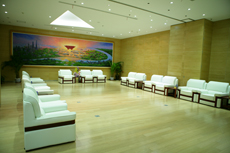 |
 |
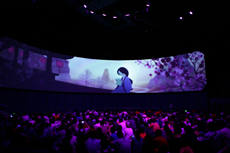 |
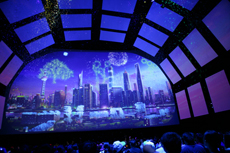 |
 |
 |
 |
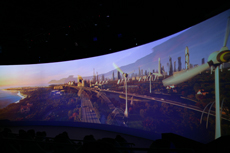 |
 |
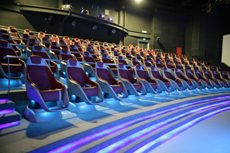 |
 |
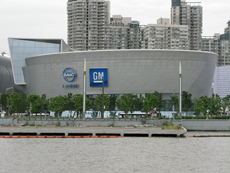 |
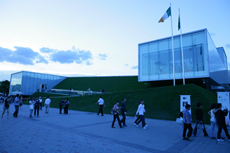 |
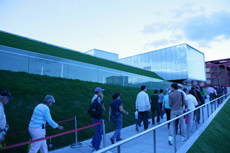 |
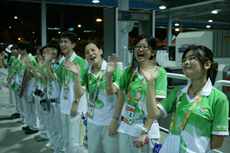 |
|
| |
| Top of Page |
|
|
